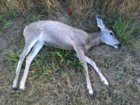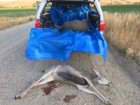I apply for pronghorn doe/fawn tags in Wyoming every year, but haven't been drawn for the past several years in a row. Occasionally I will put in for deer doe/fawn tags, but deer hunting is not my favorite field activity. Last spring my big game freezer was down to the last few tubes of venison burger, so I applied for pronghorn and deer tags for the 2018 season. As usual, I got skunked on the pronghorn tags, but did draw two deer doe/fawn tags.
I only had a few days to spend in Wyoming, but I've hunted the same area for 30 years, so I knew where to look for deer. I drove from Washington to Wyoming yesterday and arrived with a couple of hours of daylight still left, checking all the usual spots for deer. The alfalfa fields were loaded with deer (mostly mule deer, but some whitetails), filtering in just before sunset from the surrounding sagebrush hills and cottonwood river bottom. I stopped counting at 200.
With the almost-full moon I was expecting that the deer would feed most of the night and head back to cover before shooting light this morning, but nevertheless I parked my truck in the dark at 6AM, climbed a hundred yards up the hill adjacent to an alfalfa pivot, and deployed my stand-up Bog-Pod.
The eastern sky started graying around 6:15AM. I could make out some shapes a couple of hundred yards away in the alfalfa field, but even through the Leupold VX-6 4.5-14x56 I couldn't tell if the shapes were deer or pronghorns. By 6:30 I could see that they were mule deer. By 6:45 the antlers of the dozen or so bucks became distinguishable. The herd of 20 or so deer were walking in the direction of my truck, but angling away from me. [They wouldn't have let me park that close to them, so they must have been farther away in the field when I drove up.] The deer weren't really afraid of the truck, but did stop to check out this new "landscape feature."
I picked out a yearling doe that was standing broadside. I had the scope cranked up to 10x to be sure that she wasn't a spike in the weak dawn light. I had a reasonably steady hold with the Bog-Pod, so I squeezed the Jewell trigger on my Remington 700 Sendero .300 Winchester Magnum. [I don't think that a .300WM is needed for deer, but it's the only repeater I have that is larger than a 22BR.] The recoil prevented me from seeing the bullet hit, but I heard a good impact sound. I lasered the deer later and it proved to be a 290 yard shot. The 180gr Barnes TSX broke both shoulders, scrambled the vitals, and dropped the doe on the spot. [76.4gr H4831SC, WLR primer, RWS Ruag brass bullet 0.050 off the lands.]

Mule deer being what they are, the herd didn't panic. In fact, several deer trotted in my general direction since I was in the path of their normal route to their daytime bedding areas. I found another doe (early-born fawn or yearling) in the scope. She was facing me. I hesitated for a moment, knowing that the 180gr TSX would go end to end. Still, I took the shot at 168 yards. Again, I lost sight of her due to the rifle's recoil, but heard the telltale "whump" of a chest hit.

One thing that I hate about hunting deer (vs. pronghorn) is that I usually can't drive my truck to the kill, so I have to butcher the deer in the field. This time was happily different -- both deer were within a 30-yard drag to the ranch road. But compared to antelope, mule deer are heavy! I managed to wrestle the second doe into the bed of the Tacoma, but the first doe was just too damn big for me, so I field-dressed her to get her weight down to a manageable level.

I drove back to the motel, hung my deer, and spent the next several hours butchering my mulie double (the third consecutive deer hunt where I have filled both tags from the same herd at the same time). I started with the second doe to get her punctured digestive tract out as soon as possible. Sure enough, the frontal shot had broken her breastbone, jellied the vitals, penetrated completely through the alfalfa-filled rumen, and exited just in front the left rear leg. For all I know that TSX is still going. Mercifully the tenderloins didn't get any gut juice on them!
Mercifully the tenderloins didn't get any gut juice on them!
With my deer hunt over in the first 30 minutes of the day, tomorrow I'll have to see if I can find any coyotes. I have my fresh bait pile out.
I only had a few days to spend in Wyoming, but I've hunted the same area for 30 years, so I knew where to look for deer. I drove from Washington to Wyoming yesterday and arrived with a couple of hours of daylight still left, checking all the usual spots for deer. The alfalfa fields were loaded with deer (mostly mule deer, but some whitetails), filtering in just before sunset from the surrounding sagebrush hills and cottonwood river bottom. I stopped counting at 200.
With the almost-full moon I was expecting that the deer would feed most of the night and head back to cover before shooting light this morning, but nevertheless I parked my truck in the dark at 6AM, climbed a hundred yards up the hill adjacent to an alfalfa pivot, and deployed my stand-up Bog-Pod.
The eastern sky started graying around 6:15AM. I could make out some shapes a couple of hundred yards away in the alfalfa field, but even through the Leupold VX-6 4.5-14x56 I couldn't tell if the shapes were deer or pronghorns. By 6:30 I could see that they were mule deer. By 6:45 the antlers of the dozen or so bucks became distinguishable. The herd of 20 or so deer were walking in the direction of my truck, but angling away from me. [They wouldn't have let me park that close to them, so they must have been farther away in the field when I drove up.] The deer weren't really afraid of the truck, but did stop to check out this new "landscape feature."
I picked out a yearling doe that was standing broadside. I had the scope cranked up to 10x to be sure that she wasn't a spike in the weak dawn light. I had a reasonably steady hold with the Bog-Pod, so I squeezed the Jewell trigger on my Remington 700 Sendero .300 Winchester Magnum. [I don't think that a .300WM is needed for deer, but it's the only repeater I have that is larger than a 22BR.] The recoil prevented me from seeing the bullet hit, but I heard a good impact sound. I lasered the deer later and it proved to be a 290 yard shot. The 180gr Barnes TSX broke both shoulders, scrambled the vitals, and dropped the doe on the spot. [76.4gr H4831SC, WLR primer, RWS Ruag brass bullet 0.050 off the lands.]

Mule deer being what they are, the herd didn't panic. In fact, several deer trotted in my general direction since I was in the path of their normal route to their daytime bedding areas. I found another doe (early-born fawn or yearling) in the scope. She was facing me. I hesitated for a moment, knowing that the 180gr TSX would go end to end. Still, I took the shot at 168 yards. Again, I lost sight of her due to the rifle's recoil, but heard the telltale "whump" of a chest hit.

One thing that I hate about hunting deer (vs. pronghorn) is that I usually can't drive my truck to the kill, so I have to butcher the deer in the field. This time was happily different -- both deer were within a 30-yard drag to the ranch road. But compared to antelope, mule deer are heavy! I managed to wrestle the second doe into the bed of the Tacoma, but the first doe was just too damn big for me, so I field-dressed her to get her weight down to a manageable level.

I drove back to the motel, hung my deer, and spent the next several hours butchering my mulie double (the third consecutive deer hunt where I have filled both tags from the same herd at the same time). I started with the second doe to get her punctured digestive tract out as soon as possible. Sure enough, the frontal shot had broken her breastbone, jellied the vitals, penetrated completely through the alfalfa-filled rumen, and exited just in front the left rear leg. For all I know that TSX is still going.
With my deer hunt over in the first 30 minutes of the day, tomorrow I'll have to see if I can find any coyotes. I have my fresh bait pile out.










